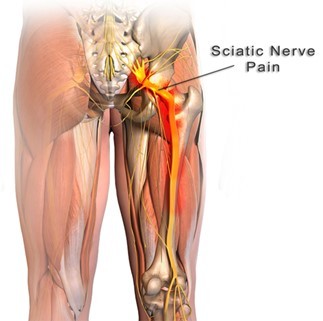The sciatic nerve is the longest, largest nerve in your body and is about the size of a man’s thumb in some areas. It originates in the lower back, radiates deep into the buttock, and goes down the leg to the feet. It is vital for control of your movement, balance, and sensation. Irritation or compression of the sciatic nerve causes pain accompanied by numbness, weakness, and loss of function. The most common cause of sciatica is due to herniated or slipped disk causing pressure on the sciatic nerve. Pain is described as sharp, stabbing, shooting pain that feels worse if you sit or stand too long. Even any sudden movement like coughing or sneezing can cause severe pain. Bless you!
The nerve is made up of five nerve roots: two from the lumbar spine and three from the pelvis running through the piriformis gluteal muscle area coming together to form the right and left sciatic nerve. It continues down the back of the knee where it divides into 2 nerves (tibial and common peroneal nerve. Pain associated with sciatica may be symptoms of some underlying medical conditions such as 1. degenerative disc disease, 2. spinal stenosis, and 3. piriformis muscle syndrome, etc. Poor workplace ergonomics can be a contributing factor. Symptoms may be felt on only half of the body and depends on where the sciatic nerve roots are compressed.
About 10% – 40% of people (more often men) aged 40 years or older suffer from sciatic nerve pain. If left untreated, sciatica can potentially cause permanent nerve damage and other complications can occur.
Sciatica is a symptom of a medical problem, not a condition by itself. Finding the source of the pain and treating it is important.
Treating Your Pain Associated with Sciatica
A healthcare professional’s goal is to locate the source of your sciatica pain and begin your physical examination along with a formal treatment plan. Reducing your pain, improving muscle weakness, and muscular rehabilitation can effectively be done. Most of the sciatica conditions do not require surgery and treatments can be accomplished by using non-invasive therapies such as Electric cell-Signaling Treatments (EcST). In most cases, patients require little or no prescription medication because these treatments are so effective.
RST-SANEXAS neoGEN® Electric cell-Signaling Treatments (EcST)
If you are experiencing pain associated with sciatica or any other painful conditions, RST-SANEXAS neoGEN® Electric cell-Signaling Treatments (EcST) will help relieve your pain and other symptoms. These treatments are safe, effective, non-invasive, and non-pharmaceutical. You can return to living your best life. Embrace HOPE with your heart. This is the pathway to living a pain-free life.
Visit https://www.rstsanexas.com/patient.resources or https://www.rstsanexas.com/find.a.doctor


